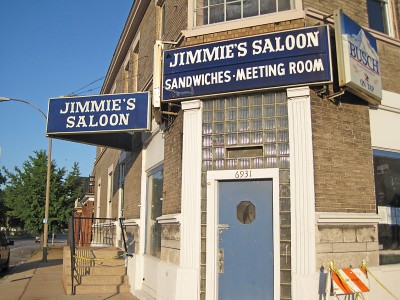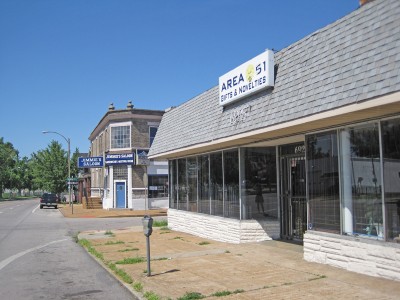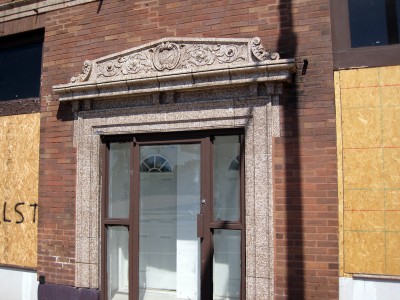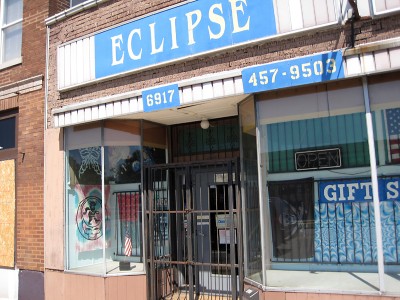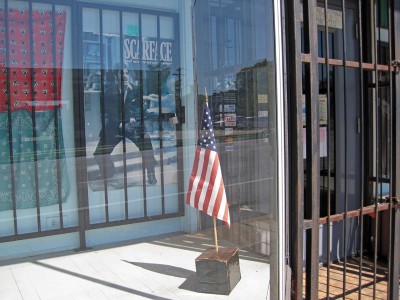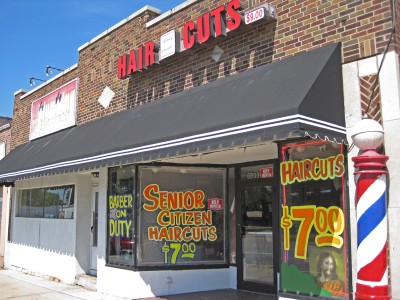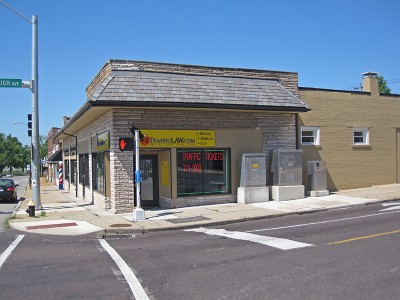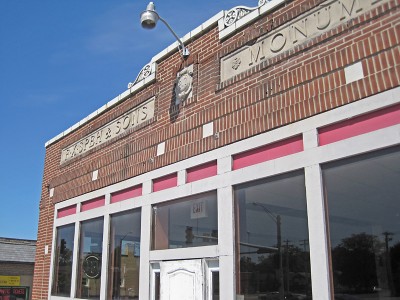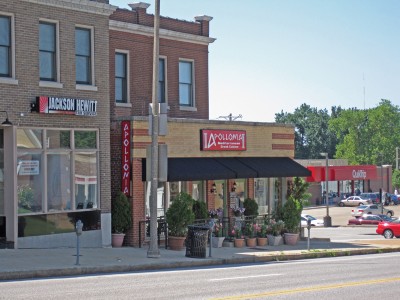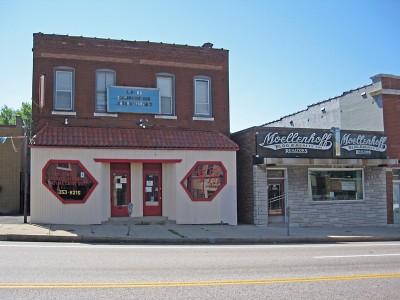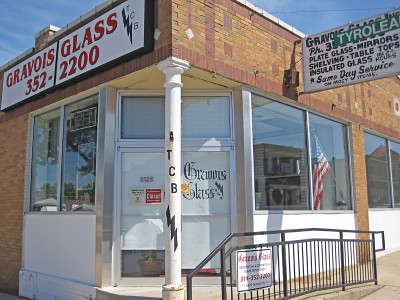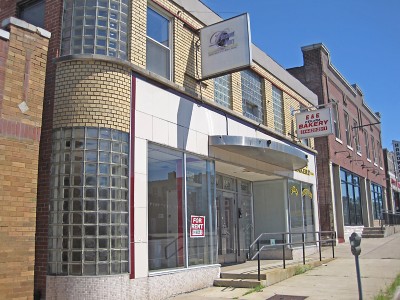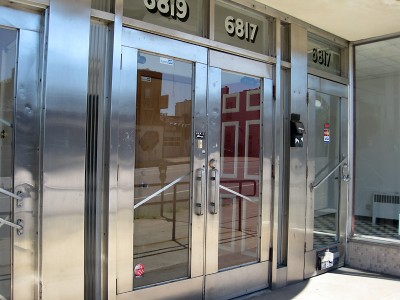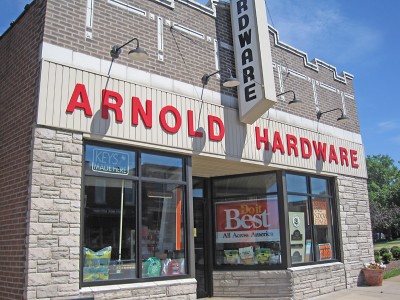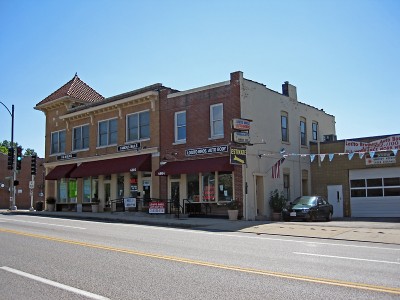Gravois & Quincy in the Princeton Heights neighborhood
South St. Louis, MO
There’s been some renovation work going on at the Jimmie’s Saloon building (built circa 1906). Permits are taped to the windows, and one day, all of the 2nd story windows were gone in anticipation of replacements. As happy as I am to see it coming back to life, I worry about the fate of the signage… will they keep it in place? Oh please, say yes!
So I had other places to be on this Sunday morning, but stopped just a moment to take a few photos of the signage, and peer through the windows to see what they’re up to. Then I started looking around and in that moment of looking I finally SAW this part of town, and I just kept walking and snapping, totally gaga over finally seeing the truth.
I saw that in the same block we have two head shops. I’ve been in one of them before, but can’t quite remember which one it was, heh heh. This started life in the early 1920s as a Kroger grocery store, and also housed Southside Cyclery before they moved to a bigger space just on the other side of the Jimmie’s Saloon block.
I saw that from Quincy to Kingshighway, this section of the Princeton Heights neighborhood was dense and alive and useful. It was everything we remember/crave in an urban environment, and it’s all going on without any revitalized fanfare because it just keeps on keeping on.
The head shops are divided by a building all vacant and boarded up, slightly forlorn, but look at that entrance!
This building is circa 1924, and used to be a 5 and 10 cent store.
This block of Gravois is directly across the street from the QT. That side of the Loughbourough intersection has been demolished and given car-centric infill, but the rest remains refreshingly intact and vital.
This place still retains part of the Ragsdale Beauty Shop legacy, evolving into Randy Ragsdale’s barber shop.
This building just recently came back to life with a new business. And even though this circa 1924 building has been greatly altered throughout its life, all it took to abide by the latest tenant was lots of paint, new doors and grill work and some ingenious interior remodeling to be back in action.
This place (built circa 1920) has long been a curiosity to me. It underwent a renovation around 2004-2005, with new windows, tuckpointing, refurbished interior… it was a joy to watch it coming back to life after being vacant for so long. This building is too pretty and in too prime a spot to still be vacant.
Directly across the street is a favorite neighborhood restaurant to walk to. The original building dates from 1908, with a newer bump out. To one side is the suburban-esque tear out for a former 7-11 (and that building is being re-used, which is good), while the other side of Apollonia continues on up the hill without any interruption to the original density. Actually, both sides of this block are uninterrupted, which is a glorious (and rare) sight to behold.
Moellenhoff’s neon sign is an old beauty, but it’s not the original business for the spot. And the circa 1907 building right next door is also owned by the Moellenhoffs, now housing Bo Fung Chinese, which has been there seemingly forever because it’s pretty good take-out. I also love the the nonsensically off-kilter windows of the newer-period street-level bump out.
One thing to note about all the businesses in the blocks between Lougborough and Kingshighway: On-Street Parking. Not a one of them has a parking lot visible from Gravois. And many of the businesses in this block have been there “forever,” so this does not seem to be a detriment. I wish City Hall would take note of this the next time a new city business says they need to tear down a perfectly good building next door for more parking. If you maintain the density of the area, a quarter of the people walk to the place, another quarter takes the bus, and the driving half never seem to have too tough a time with parking to keep them from coming back.
Gravois Glass is one of those businesses that also seems to have been here forever, though the Elvis TCB on the corner post and signage is a relatively recent addition. Which just makes them cool.
I absolutely adore this building, which dates to circa 1948. With Vitrolite and glass block and stainless steel, it’s simply Retail Art Deco charming.
It’s a minor miracle that the original doors have remained in place, and standing next to them always makes me feel all cosmopolitan and clean. Need to do some research to see what was originally in these two separate store fronts (or if you know, do speak up). There’s been a few different business in here since the 1990s, and a Bosnian bakery just only recently closed. Here’s hoping new tenants arrive soon, and that the owners continue to baby this fabulous facade because that is the calling card.
Here’s the true King of Forever on this block – Arnold Hardware. Ain’t nothing can dent their productivity, not even the bank and its parking lot that went in next door a few decades ago. That bank killed the density winning streak on this side of the block, but across the street…
…these two buildings continue the chain all the way to a break in “the wall” for the old St. Marcus cemetery/park. Losito Brothers Auto carries on the tradition of that spot, while the clay tile roof of the tower is always a striking sight (in fact, it inspired one renter of a house behind here to draw it on a bedroom wall!).
I was gloriously lost in crushing hard on these few blocks I’d seen and used a thousand times but never appreciated fully, when I realized I was supposed to be somewhere else and better get a move on. I need to come back with a better camera and also do some research where the awesome website of the Princeton Heights Neighborhood Association has yet to fill in.
And while driving away, I – who does not have a degree in urban planning and such – wondered exactly how did these few blocks survive so relatively intact? How did they remain so consistently vital while other similar blocks in similar neighborhoods did not? Let’s also ponder how little attention they get because they never died and needed oxygen pumped back into its lungs.
The City of St. Louis has plenty of workhorse stretches of original density and vitality that deserve a little lovin’ for takin’ care of business for so long. They may not be glamorous by revitalization standards, but you don’t have to be a star, baby, to be in my show. I just love knowing that you’re always there for us!

